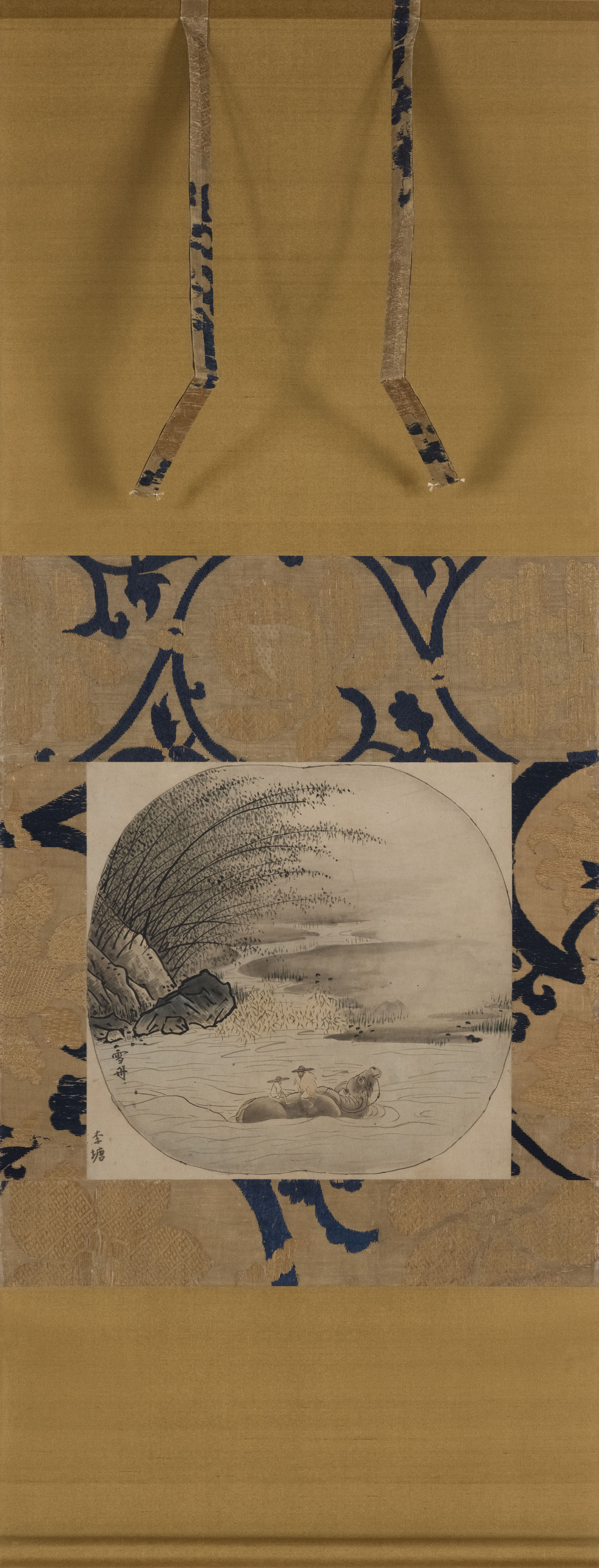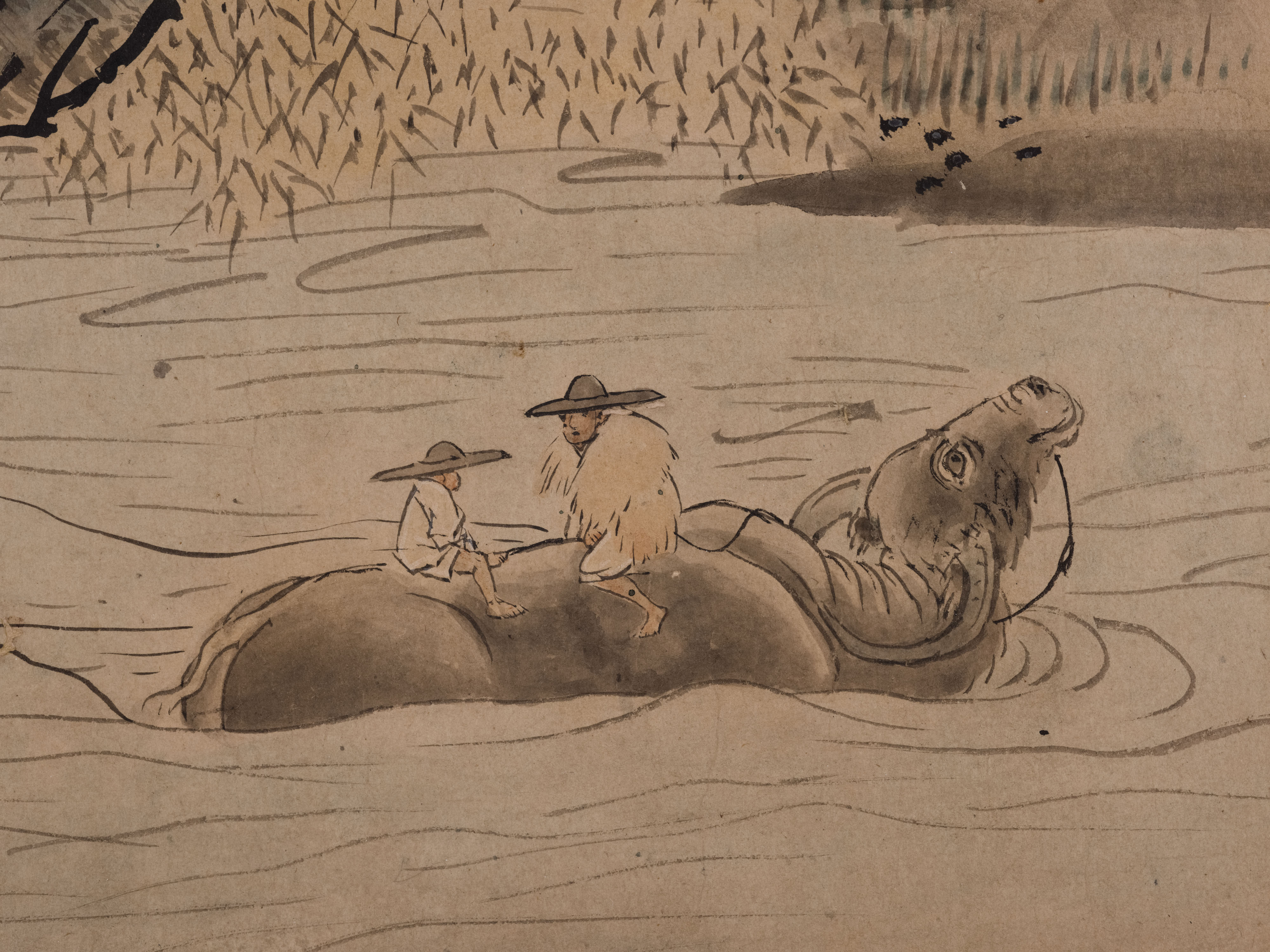
ぼくぎゅうず(とが) 牧牛図(渡河)
15th century(室町時代 15世紀)
紙本墨画淡彩
画面の左下の団扇形の枠線の内側に「雪舟」という署名が記され、枠線の外側、画面の左下隅に、「李唐」という13世紀初めの中国人画家の名前が記されています。雪舟が、中国の古典的な名画をお手本に描いたシリーズ作品のうちの一枚です。画面には、河を渡る水牛の背に、つばの広い笠をかぶった親子が向かい合ってまたがっている姿が描かれています。水牛の歩みが水面に作る波紋を、柔らかい線を用いてとても巧みに描きだしています。画面左側の崖を描く部分、竹林の根元辺りに、小さな虫喰いの跡がありますが、もう一幅の牧牛図(牧童)にも画面の同じ部分に虫喰い跡があります。つまり、これら二枚の絵は、ある時期、表装を取り外した形で重ねて保存されおり、その時に虫が喰って穴が開いたのだということが分かります。これらの雪舟の団扇形のシリーズは、本来は掛け軸ではなく、画帖(アルバム)に貼られていたものと思われます。
雪舟等楊【せっしゅう とうよう】
生没年 1420~ca.1502(応永27年〜文亀2年頃)
日本美術史を代表する水墨画家。備中国(現在の岡山県)に生まれ、京都での禅僧としての修行を経て1454年(享徳3年)頃から大内氏の庇護を受けて山口に移住。1467年(応仁元年)、遣明使に参加して中国に渡り、本場の水墨画を学びました。個人としては最多の6点が国宝に指定されています。
| 寸法 | 30.3×31.5cm |
|---|---|
| 形状 | 掛幅 |

Herdsman and water buffaloe
15th century
Ink and light color on paper
The picture has the artist’s autograph, “Sesshu”, in the left-hand part of the picture and inside the fan-shaped circle. The name of a Chinese painter, “Li Tang”, who lived in the 13th century, is outside the circle in the lower left-hand corner of the picture. This painting is one of Sesshu’s series of works that were modeled upon masterpieces of Chinese art. The work depicts a father and his son, who are crossing a river by riding on the back of a buffalo. They are wearing wide-brimmed straw hats, and are facing each other as they ride. The rippling water is very subtly depicted, using soft lines. In this picture, there are some wormhole traces in an area where rocks are drawn near the base of a clump of bamboo.
Another work, also in the Oxherding picture (Herdboy) series has similar traces of wormholes in the same section of the picture. This suggests that these two works had been stored on top of one another for some period, with the mountings removed, during which time they were damaged by worms. It seems that Sesshu’s fan-shaped-circle series were appreciated by being enclosed in an album, rather than being mounted as hanging scrolls.
Sesshu Toyo (1420 – 1502)
In Japanese art history, Sesshu Toyo is a landmark ink painter. He was born in Bicchu Province (the present-day Okayama Prefecture). After training as a Zen monk in Kyoto, around 1454 he moved to Yamaguchi under the patronage of the Ouchy family. In 1467 he went to Ming Dynasty China, accompanying a Japanese mission, and learned the art of ink painting there, in the very home of ink painting. A total of six of his works have been designated as National Treasures. This is the maximum number of works so designated for any individual artist.
| Size | 30.3×31.5cm |
|---|

牧牛圖(渡河)
畫麵左下的團扇形線框內側,有“雪舟”的署名,畫麵左下的線框外側,寫有13世紀初的中國畫家“李唐”的名字。此畫是雪舟以中國古典名畫為範本繪製的係列作品之一。畫上描繪著,頭戴寬簷鬥笠的父子麵對麵騎坐在渡河的水牛背上的情景。水牛行走在水麵上帶起的波紋,用柔和的線條巧妙地表現出來。畫麵左側的山崖部分,竹林根部有蟲蛀的痕跡,另一幅牧牛圖(牧童)畫麵的相同部分也有蟲蛀的痕跡。由此可見,這兩幅畫在某個時期,被卸去裝裱疊放保存,這個時候被蟲蛀了洞。也可以推測出,這些雪舟的團扇形係列,原本並不是掛軸,而是貼在畫冊(相簿)裏的。
雪舟 等楊
生卒年 1420~ca.1502(應永27年~文龜2年前後)
日本美術史上的代表性水墨畫家。出生於備中國(現在的岡山縣),在京都作為禪僧修行,享德3年(1454年)起,受大內氏保護移居山口。應仁元年(1467年),參加遣明使前往中國,學習了正宗的水墨畫。是個人作品中榮譽最多的,有6件被指定為國寶。
| 尺寸 | 30.3×31.5cm |
|---|

목우도(도하)
화폭 좌측 하단, 둥근 부채 형태의 테두리 안쪽에 「雪舟(설주 *일본 음독: 셋슈)」라고 작가의 서명이 쓰여 있습니다. 테두리 선 바깥쪽, 화폭 좌측 하단 구석에는 「李唐(이당)」이라는 13세기 초 중국인 화가의 이름이 적혀있습니다. 이 작품은 셋슈가, 중국의 고전적인 명화를 참고로 그린 시리즈 작품 중 한 장입니다. 화폭에는 강을 건너는 물소의 등에 테가 넓은 삿갓을 쓴 부자가 서로 마주 보고 앉은 모습이 그려져 있습니다. 물소의 걸음에 따라 만들어지는 수면의 파형을, 부드러운 선을 사용하여 굉장히 정교하게 그려냈습니다. 화폭 좌측 벼랑을 그린 부분, 대나무 숲 뿌리 쪽 부분에 벌레 먹은 흔적이 남아있는데, 다른 한 폭의 작품 ‘목우도(목동)’에도 같은 부분에 벌레 먹은 흔적이 있습니다. 즉, 이 두 장의 그림은 한 시기, 표장을 벗겨내고 겹쳐서 보존된 적이 있으며, 그 때 벌레로 인해 구멍이 생겼다는 것을 알 수 있습니다. 셋슈의 이러한 둥근 부채형 그림 시리즈는 원래 족자가 아닌, 화첩 즉, 앨범에 붙여져 있었던 것으로 생각됩니다.
셋슈 도요
생몰년 1420년 ~ 1502년경 (오에이27년~분키2년경)
일본 미술사를 대표하는 수묵화가입니다. 빗추국(현재의 오카야마현)에서 태어나, 교토에서 선종 승려로서 수행을 거친 후, 1454년(교토쿠3년) 경부터 오우치씨의 비호를 받아 야마구치로 이주하였습니다. 1467년(오닌원년), 견명사가 되어 수묵화의 본고장인 중국으로 건너가 수묵화를 공부했고, 개인으로서는 가장 많은, 총 여섯 점의 작품이 국보로 지정되어 있습니다.
| 치수 | 30.3×31.5cm |
|---|


